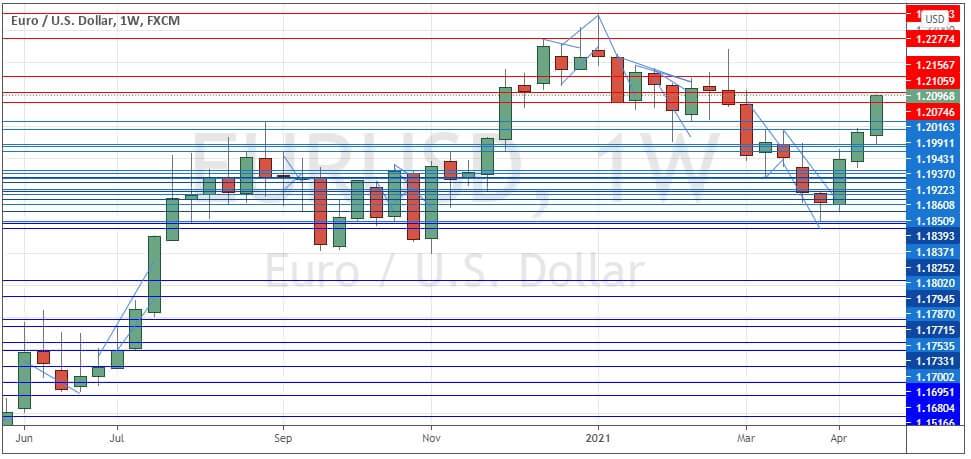Forex Forecast: Pairs In Focus - Sunday, April 25
The difference between success and failure in Forex trading is very likely to depend mostly upon which currency pairs you choose to trade each week and in which direction, and not on the exact trading methods you might use to determine trade entries and exits.
When starting the trading week, it is a good idea to look at the big picture of what is developing in the market as a whole and how such developments and affected by macro fundamentals and market sentiment.
It is a good time to be trading markets right now, as there are a few valid long-term bullish trends in major U.S. and European stock market indices, which can be traded at most Forex brokers as CFDs, as well as medium-term momentum in favor of the euro and the Japanese yen and against the U.S. dollar.
Big Picture April 25
Last week’s Forex market saw the strongest rise in the relative values of the euro and the strongest fall in the relative value of the U.S. dollar.
I wrote in my previous piece last week that the best trades were likely to be long of the S&P 500 and Dax 30 Indices. While the S&P 500 Index ended the week virtually unchanged, the Dax 30 Index closed down by 1.54%, giving an average loss of 0.77%.
Fundamental Analysis & Market Sentiment
The headline takeaway from last week is that market sentiment remains risk-on, especially on the U.S. and the Eurozone centered on Germany. Demand has been stoked by dovish monetary policies plus stimulus in the U.S., despite fears that policy will lead to untenable inflationary pressures and of higher corporate taxes. The major U.S. stock index, the S&P 500, briefly traded at a new all-time high price on Friday.
The U.S. dollar fell again over the past week after running into technical resistance three weeks ago, while its long-term trend is mixed. There is medium-term momentum against the dollar while there is similar bullish momentum in favor of the euro and to a lesser extent the Japanese yen. We also see long-term strength in the Canadian dollar, which is backed by fundamental factors and the policies of the Bank of Canada.
Last week was dominated by monthly policy releases from the European Central Bank, which contained no surprises and had little effect on the euro, and the Bank of Canada, whose release was more consequential as it moved forward the anticipated timetable for the commencement of rate hikes.
The main events this coming week will be the Federal Funds Rate and FOMC Statement from the U.S. Federal Reserve, plus U.S. Advance GDP data and the Bank of Japan’s Outlook Report. Typically, FOMC releases are the major driver of Forex market volatility, so we can expect an active Forex market during the second half of this week.
Last week saw the global number of confirmed new coronavirus cases rise for the eighth consecutive week to new record highs, after falling for over two months, driven mainly by a resurgence of the virus in Asia (especially India). The total number of global deaths also rose again last week for the fifth week running. There is considerable informed speculation that the death tally in India is considerably higher than the official total running at approximately 2,600 daily, while at present there are about one million new confirmed cases every three days.
Many countries have begun vaccination programs. Excepting extremely small nations, the fastest progress towards herd immunity has taken place in Israel, the U.K. and the U.A.E., with studies claiming that Israel and the U.K. have reached de facto “herd immunity”. Immunization is proceeding quickly in the U.S. and the European Union has finally begun to quicken the pace of its program sufficiently to begin to make a difference.
The strongest growth in new confirmed coronavirus cases is happening in Argentina, the Bahamas, Bolivia, Cambodia, Colombia, Croatia, Cuba, Cyprus, Egypt, Georgia, India, Iran, Iraq, Japan, Kazakhstan, South Korea, Malaysia, Nepal, Netherlands, Paraguay, Saudi Arabia, Sri Lanka, Trinidad, Tunisia, Turkey, Venezuela, and Uzbekistan.
Technical Analysis
U.S. Dollar Index
The weekly price chart below shows the U.S. Dollar Index printed a firmly bearish candlestick last week after rejecting the key resistance level a few weeks ago shown above the current price in the chart below and making a bearish reversal. New lower resistance levels have been printed on the way down, which is a bearish sign. The index is still barely above its price from three months ago, which is a bullish sign, but is further below the key resistance level mentioned as well as sitting below its price from six months ago, suggesting bearish momentum has developed. Overall, next week’s price movement in the U.S. dollar looks slightly likely to be downwards. For this reason, it will probably be wise to not take any long USD trades over the coming week.
S&P 500 Index
The incredible rise of the U.S. stock market since the initial impact of the coronavirus in March 2020 continues, with the price holding its ground last week to briefly trade Friday at another all-time high. This was really a pause in the recent strong rise, so bulls will probably do well to be a little careful here and wait for a daily close above 4200 before looking to get long again. Above that level, the price will be in blue sky with bullish momentum, which would suggest the rise would then be likely to continue for some days.
EUR/USD
Although there is no long-term trend, the weekly chart below shows we have seen relatively powerful bullish momentum over the past three weeks, with the real bodies of these candlesticks larger than we have seen for several months. We can therefore say there is a bullish medium-term trend which may continue to at least the resistance level at 1.2227 which caps the recent inflective long-term high price above.
USD/JPY
Although there is no long-term trend, the weekly chart below shows we have seen relatively powerful bearish momentum over the past three weeks, with a clear bearish inflection point having impact from the psychologically important 110.00 area. We can therefore say there is a bearish medium-term trend which may continue to at least the support level at 106.67 shown as a likely key level in the price chart below.
Bottom Line
I see the best likely opportunities in the financial markets this week being long of the S&P 500 following a daily (New York) close above 4200, and in cautious short-term trades long of EUR/USD and short of USD/JPY.








